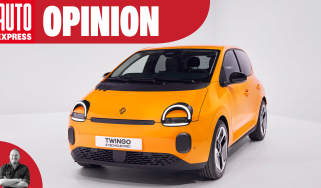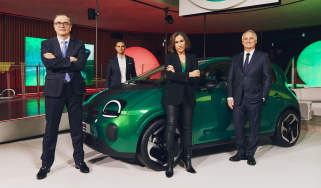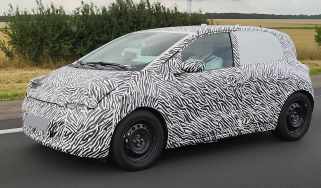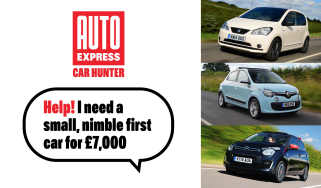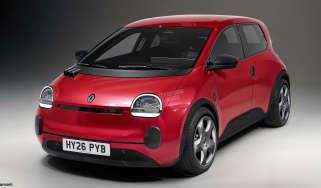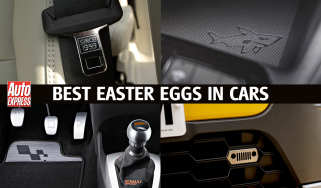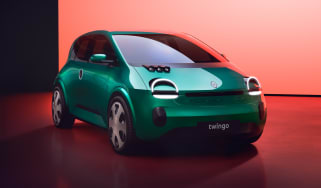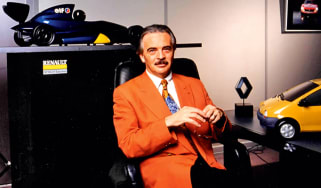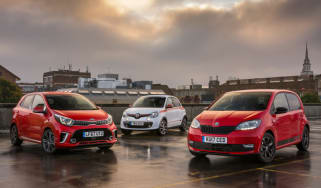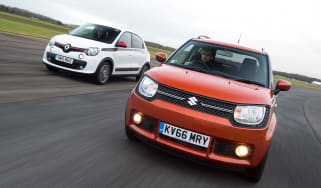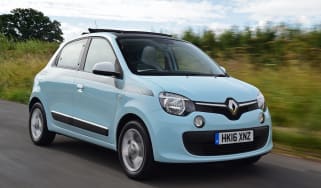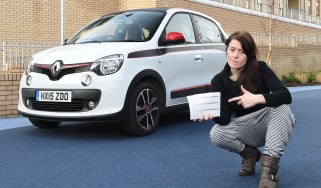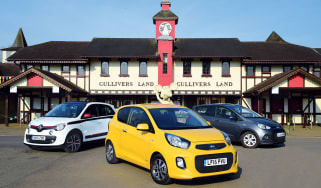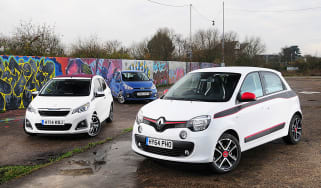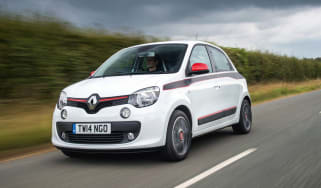Renault Twingo (2007-2014) review
The Renault Twingo has a sporty rear-engined layout, but it's a bit of a disappointment

Whether you think that the Renault Twingo is quirky, cute or charismatic, there’s no doubt it’s an interesting addition to the booming city car sector.
It has an unusual layout for the class, with the three-cylinder engine tucked under the boot floor, and whether you go for the 70, 90 or 100 versions, it drives the rear wheels. This means rather different packaging to most urban runabouts that frees up lots of room, while the layout also allows a turning circle that’s as tight as a London taxi’s – perfect for city living.
But the driving experience isn’t up to the increasingly exacting standards of the best choices in this market, especially when you’re out of town. Ultimately the Twingo lacks the refinement and ‘big car' feel you get from the city class leaders.
With tough competition in the city car sector, the Renault Twingo is one of the forgotten cars for sale in the class. With its rear-engined layout, it sounds like it should be sporty, but while a GT model was offered, the Twingo isn't much fun to drive.
Where it performs best is when it's used as a city car, where its super-tight turning circle and nippy engines deliver a drive that makes negotiating city traffic a breeze. But that's where the Twingo needs to stay, because if you venture beyond the city, the car's shortcomings become apparent.
Used - available now

2024 Vauxhall
Crossland
12,956 milesManualPetrol1.2L
Cash £12,397
2026 Volkswagen
Polo
18,939 milesManualPetrol1.0L
Cash £15,397
2025 Suzuki
S-Cross
15,351 milesManualPetrol1.4L
Cash £14,997
2019 Volkswagen
Arteon
83,604 milesAutomaticDiesel2.0L
Cash £14,697The current Twingo is the third generation, and the second version to be sold in the UK. While the Mk2 offered an RS Renaultsport-tuned variant, the closest the current Twingo gets to a sporty variant is the Twingo GT. This has more power than the rest of the range, and while Renaultsport had a hand in its development, the VW up! GTI is a far better budget sports car.
The standard Twingo range is powered by either a 1.0-litre three-cylinder or a 900cc turbo three-cylinder. These are badged SCe 70 and TCe 90 respectively, and it's the TCe that we'd choose. It has better mid-range power, making it more useable around town where the Twingo performs well.
An update in 2018 saw the older trims replaced by Play and Iconic specs, while the GT is no longer offered in the lineup. The TCe motor can only be had in Iconic trim, while it can also be had with an EDC auto gearbox, although we wouldn't recommend this box if you can avoid it.
Thanks to its rear-engined layout, the Twingo has a high-set boot, but it also has good rear seat space. Room up front is good, too, although material quality could be better. Unlike some other cars that have their engine behind the cabin, the Twingo's design means there's no extra storage in the nose.
How much does the Renault Twingo cost?
As of 2025, the Renault Twingo is no longer available as a new car in the UK, with production of the current model having ended. However, Renault has confirmed that an all-new electric Twingo will arrive in 2026, targeting a starting price under £17,000—positioning it as one of the UK’s most affordable EVs.
In the meantime, used Twingo models remain widely available. Early-generation examples (2010–2012) can be found from around £2,000, while newer models (2016–2018) typically range between £5,500 and £8,000 depending on mileage and condition. If you're looking for a budget-friendly city car with character, the Twingo is still a strong contender on the second-hand market.
Engines, performance and drive
Thanks to its rear-engined, rear-wheel-drive layout, the Twingo is a tantalising prospect as a driver’s car. However, the arrangement has more to do with practicality and packaging than driving dynamics.
If you were expecting a city car with the agility of a Porsche 911, you’ll be disappointed, but positioning the drivetrain at the back has some advantages. It enables the Twingo's front wheels to turn through 45 degrees, giving it a class-leading turning circle of just 8.6 metres. Around town, you can make turns that only a London taxi or a Toyota iQ can rival.
Parking the Twingo is a breeze, too, while the seating position really helps visibility – you sit higher up in the Renault than you do in most of its city car rivals. The elevated position is perfect for making the most of the tight turns and manoeuvring in and out of tight spaces.
The variable-rate steering means the wheel is light and easy to turn at low speed, boosting manoeuvrability. The steering does weight up as you gain speed, but the set-up is far from perfect. It makes the Renault seem unnatural and vague in corners, whereas rivals like the Skoda Citigo respond more keenly to your inputs.
No matter which model you go for, the Twingo is a fairly comfortable car. The suspension deals well enough with bumps, potholes and speed humps, although it can get a bit fidgety over rough surfaces at lower speeds, so the car never feels quite as polished as the Hyundai i10, for example. The ride gets better at speed, although there's quite a bit of wind noise from the A-pillars, which spoils the enjoyment a little.
In the Twingo GT, the very short overhangs mean it's keen to turn in, but the light, quick steering, narrow track and tall body promotes a noticeable level of roll. Renault says it’s also recalibrated the ESC for a sportier feel, but the Twingo’s stability control still feels restrictive in an effort to mask some of the chassis’s natural traits – there’s not a great sense that the car is rear-wheel drive, and the electronics keep the rear end in check on the road.
On standard 17-inch alloys the GT's ride is firm, and the stiffer chassis feels crashy over pocked roads. The GT is bouncy at speed as a result and it thumps over bumps at lower speed in town, too, but it still remains fun to drive. Overall, if you're looking for a sporty option in the city car class, then the VW up! GTI runs rings around the Twingo GT to the extent that it's redefined the small performance car brief.
Engines
Twingo buyers have a choice of three-cylinder petrol engines: a 1.0-litre with 69bhp which claims 0-62mph in 14.5 seconds and an 89bhp turbocharged 0.9-litre that promises a time of 10.8 seconds. The more powerful 99bhp version of the same engine only appears in the Twingo GT, which is no longer available new. All versions come with a five-speed manual gearbox as standard, although the 89bhp turbo is available with a six-speed EDC automatic as an option on some versions.
If you plan to do plenty of motorway journeys, the more punchy turbo will be the better bet. If not, the lower-powered engine is the nicer car to drive in town.
Even the turbocharged Twingo doesn't enjoy the 'big car' feel of a Skoda Citigo or its SEAT Mii and Volkswagen up! sister cars. The VW Group trio also ride better and deliver far more mature body control, plus they are considerably quieter at speed – although they don’t have the character of the Twingo.
Despite its lacklustre performance figures, the lower-powered car is nippy enough around town, which is primarily where it was designed to be used. It even feels more responsive than the turbo, which is a bit sluggish off the mark until the boost kicks in.
When revved hard, the more powerful engine is noisier than the naturally aspirated 1.0-litre, and the turbo whine can be unpleasant at very high engine speeds. The two versions of the Twingo deliver similar economy.
In the Twingo GT, the revised engine mapping doesn’t make the power delivery feel very linear. Squeeze the throttle in second, and the Twingo climbs on boost as the turbo wakes up, accelerating at a faster rate than you might have expected. However, the remainder of the throttle travel doesn’t have quite the same effect – the engine gives more of its performance at the top of the pedal’s travel.
However, it’s a surprisingly quick little car. The 898cc turbo triple serves up 108bhp and an impressive 170Nm of torque, which given the car only weighs 1,001kg meant the GT accelerated from 0-60mph in 9.6 seconds when we tested it. This was four tenths faster than the VW up! TSI, but four-tenths slower than a Smart ForTwo Brabus. In-gear between 30-50mph the Twingo matched the ForTwo, taking 3.7 and 5.1 seconds in third and fourth respectively. However, the gearshift isn’t as precise as a VW up’s, with a more indistinct feeling when it comes to slotting the ratios.
MPG, CO2 and Running Costs
Efficiency has been a Twingo calling card ever since it was first launched, and that trait is maintained under the latest WLTP test regime. The SCe 70 1.0-litre three-cylinder petrol engine has two fuel economy figures, as the Play model doesn't have stop-start, but the Icon version does. As a result the SCe 70 Play returns up to 47.9mpg in the latest test procedure, while the Iconic mdoel returns 48.7mpg.
These figures are significantly down on the 62.8mpg quoted in the old NEDC test. However, this is a reflection on the tougher WLTP economy test, rather than the Twingo being any less efficient than before. This engine also has emissions of 126g/km in Play guise, while the stop-start Iconic manages a far more palatable 110g/km.
Moving to the TCe 90 0.9-litre three-cylinder turbo with stop-start, fuel economy is 47.9mpg with the manual gearbox, while the auto model manages 45.6mpg. That's not too bad a penalty, although you do pay around £900 extra for the EDC auto.
Insurance groups
Insurance groups are low, with the SCe-powered cars falling into group 3, and the more poweful TCe cars in group 8. However, rivals from Skoda, SEAT and Hyundai offer lower group 1 and 2 ratings.
Depreciation
Second-hand values will be a concern for private buyers, as our experts predict that the Renault Twingo will retain only 30 per cent of its new price over three years. That puts it squarely in the bottom bracket of the city car depreciation spectrum – although considering the low starting price, you won’t lose much more in cash terms than if you chose a Volkswagen up!, which is estimated to hold on to 45 per cent of its showroom value. Lower-spec versions of the Twingo will perform best, as the second-hand market takes little notice of the cost of bells and whistles.
To get an accurate valuation on a specific model check out our free car valuation tool...
Interior, design and technology
With the Twingo, Renault’s designers have balanced just enough retro styling cues with a modern edge to make sure the car has plenty of appeal on city streets. There are hints of the Renault 5 in the shape, but the squat proportions and tiny overhangs mean it looks thoroughly up to date, with bright LED running lights mounted in the front bumper.
The oversized Renault badge sits in the middle of the Twingo’s narrow grille, with the dainty headlight clusters either side, while at the back, the black glass bootlid and small lip spoiler provide a bit of visual attitude. Renault has mounted the Twingo’s engine in the rear, which means the front is short and the wheels have been pushed as far towards the corners of the car as possible, giving a compact stance.
The Twingo looks good, but that’s not enough in today’s city car sector, so Renault has added plenty of customisation details and option packs so buyers can further tweak the style. There are Fashion, Chic, Urban and Street options to go for, or you can customise the look of your model yourself with stickers and decals.
Inside, the Renault is just as unusual as it is on the outside. There are more coloured accents for the doors, air vents, steering wheel and storage box, and while the interior can’t quite match the premium ambience of the Hyundai i10, the big, Tonka toy-style door pulls and solid plastics do feel robust.
You can spot the Twingo GT by its twin tailpipes to improve the engine’s breathing, as well as the small air intake on the rear left bodywork. Inside, the GT gets a few sportier touches, such as Renaultsport badging on the sill, a new gearlever and some artificial leather on the seats, but the interior is fairly similar to other models.
Climate, cruise control and parking sensors are standard on the GT, but quality leaves a little to be desired, with hard plastics on the dash and facia. But it’s difficult to criticise the Twingo GT as it offers lots of kit for the price, alongside an interesting design with plenty of scope for personalisation. The standard R&GO system provides sat-nav through a smartphone app, or there’s the built-in option as part of the Techno Pack, which costs around £600.
Sat-nav, stereo and infotainment
Although the Play model doesn't get the optional R-Link touchscreen sat-nav of the most lavishly equipped Twingos, there is a smartphone cradle which allows you to connect via Renault’s R&Go phone app.
This clever device effectively turns your own smartphone into a touchscreen sat-nav, as well as giving it control over the car stereo – on top of your regular phone functions, of course. Sadly, the smartphone cradle looks and feels like a cheap aftermarket item, plus it obscures some of the buttons on the dash.
On the entertainment front, even the basic car comes with DAB radio and Bluetooth and USB connectivity. Plus, you can upgrade to a six-speaker sound system with subwoofers on all models.
The optional R-Link system is part of the £600 Techno Pack, which adds a seven-inch touchscreen, Android Auto compatibility and a reversing camera. It’s a good-value add-on considering the extra functionality it brings, but it’s a shame that Apple CarPlay isn’t supported.
Renault’s system is easy to use and works pretty well, although the touchscreen isn’t particularly responsive. Often we found that it took two or three touches for the set-up to register a button press.
The reversing camera is a useful extra; it makes parking in a bay much easier, because you can see exactly how close that bollard below your rear window line is to your bumper. However, we wouldn’t say it’s a necessity.
Practicality, comfort and boot space
The Twingo is a tiny five-door hatchback with a Tardis-like interior for five people. Plus, the luggage area is highly practical and well thought out, even if it doesn’t offer class-leading space.
The driving position is relatively high, making visibility very good, and when combined with the tiny turning circle, this ensures the Renault is a doddle to drive in town. That’s not to say the driving position is perfect, though: there’s no seat height adjustment on the base model, and some Twingo owners have reported the footwell and pedals are too cramped.
On the positive side, there’s a whole host of storage spaces dotted around the cabin, including three cup-holders and a 6.4-litre glovebox. There are large rear door pockets (the Twingo has pop-out rear windows that don't need any space in the door to wind down into) and there’s also the option to add storage areas under the back seats for around £20. Meanwhile, heated front seats, with an Isofix child seat mounting on the passenger side, costs around £250.
Dimensions and size
The Renault Twingo Mk3 is a considerably different shape to its predecessor, but it doesn’t have the smallest tarmac ‘footprint’ in the class. At 3,596mm in length, the car is 5cm shorter than the Hyundai i10, but 3cm longer than the Skoda Citigo.
The cars don’t differ much for width, but the Twingo has a clear advantage on height. Its 1,554mm roofline compares to 1,500mm for the Hyundai and 1,478mm for the Skoda.
Leg room, head room & passenger space
Thanks to its rear-engined configuration, the Renault Twingo has a 22cm longer cabin than its predecessor, even though the body is 10cm shorter. This benefits rear legroom, which Renault says is class-leading. Headroom is good, too, and even tall adults will have no issues fitting in the back of this city car.
The only real problems are that the integrated front seat headrests make it hard for passengers sitting in the back to see the road ahead, while the pop-out rear windows don’t let in much fresh air; wind-down windows would be more welcome. Still, Isofix child seat mounts are standard in the back.
Boot space
On paper, the boot doesn’t seem terribly impressive – although the numbers can be deceiving. With a capacity of 188 litres, the Twingo trails all its main rivals; even the Citroen C1 and Peugeot 108 have slightly more space, at 196 litres. But in practice, the Renault’s load area is more usable than most.
The rear-mounted engine has been positioned at an angle to keep it as low as possible, while heat-proof padding prevents heat from the engine bay cooking items in the boot. Designers have ensured there is no boot lip to lift stuff over, and when combined with the relatively square space, you can actually carry bulkier items in the Twingo than you can in the deeper boots of its rivals.
What’s more, you can lock the back seats in an upright position to increase available load space to 219 litres – although they won't be very comfortable for passengers travelling sitting there. And even then, the capacity is still way off the 251 litres in the Volkswagen up!.
Still, fold the rear seats down, and the total volume of 980 litres is second only to the Hyundai i10 in this class – thanks to the Twingo's taller body. Plus, the load bay is completely flat.
The Renault trumps the Hyundai, and every other city car for that matter, with its fold-down front passenger seat. Drop this right forward, and you can carry items of up to 2.3 metres in length inside the car – ideal if you need to transport flat-packed furniture, for example.
Reliability and Safety
The Renault Twingo hasn't featured in our Driver Power satisfaction survey due to its low sales volumes. Many of its components, such as the chassis and the low-capacity engines, are firsts on this car, and we are aware of teething issues and electrical niggles with the Twingo. Indeed, when Auto Express ran a Twingo, electrical issues blighted our time with the car.
As a brand, Renault has had variable results in the Driver Power survey, with low running costs being praised, but reliability and build quality called into question. Of more concern is Renault's results in the Driver Power dealer survey. While the company came out on top in the poll of franchises a few years ago, this has been bookended by poor placings in other years.
In its 2014 Euro NCAP crash test, the Twingo scored four stars overall, with adult occupant protection rated at 78 per cent and child safety at 81 per cent. This is still a very impressive showing, and buyers should remember that the Skoda Citigo and Hyundai i10 earned their five-star ratings under an earlier and less rigorous Euro NCAP testing regime.
The Twingo comes as standard with four airbags and stability control, plus tyre pressure monitoring. All models also have a speed limiter, while the range-topping Dynamique version gets cruise control and a lane departure warning system.
Warranty
The Twingo has a standard three-year/60,000 mile warranty, reduced from the four-year cover that was originally offered by Renault when the car was first launched. In years one and two, there’s no mileage cap, but Renault limits cover to 60,000 miles in year three. If you want the peace of mind of a longer guarantee, it’s worth remembering that the Hyundai i10 comes with a five-year/unlimited mileage warranty, and the Kia Picanto has a seven-year/100,000-mile warranty.
Servicing
It shouldn’t be expensive to keep the service book fully stamped on a Twingo. However, buy the car via Renault Selections finance, and you’ll get the superb 4+ deal included – this gives you four years of servicing and roadside recovery for free.
Renault Twingo Alternatives
The main rivals for the Twingo include the all-conquering Skoda Citigo, SEAT Mii and VW up! trio, plus the Citroen C1, Peugeot 108 and Toyota Aygo models, plus the Hyundai i10, Kia Picanto and Suzuki Celerio. All these cars use a traditional front-engine, front-wheel-drive layout, but the Smart ForFour uses the same rear-engine format as the Twingo because they are essentially the same car under the skin.



